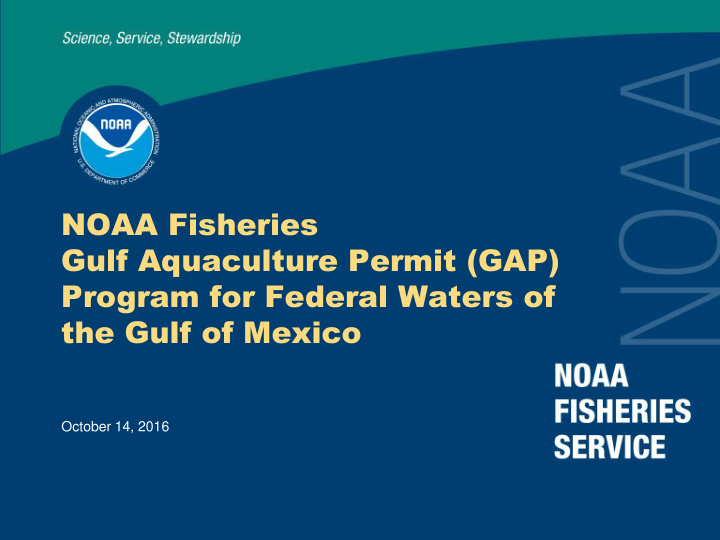



NOAA Fisheries Gulf Aquaculture Permit (GAP) Program for Federal Waters of the Gulf of Mexico October 14, 2016
Overview • Background • Key Challenges • Lessons Learned 2
Background • Gulf of Mexico Fishery Management Council approved FMP in January 2009 Primary Goal: Increase yield of fisheries by supplementing wild harvest with cultured product • FMP took effect by operation of law in September 2009 • DOC and NOAA released national aquaculture policies in June 2011 • Proposed rule published August 2014 • Final rule published January 2016 • Currently no applications (pending lawsuit) 3
Background • Up to 20 permits can be issued over 10 year period to deploy and operate an offshore facility in federal waters and sell allowable aquaculture species. • Initial permit valid for 10 years, 5-year renewal increments • Annual production limits. • 64 million pounds for entire Gulf (MSY and OY) • 20% excessive share cap ( i.e. , each business, entity limited to 12.8 mp of production annually) 4
Background Key FMP Provisions: 1. Establish operational conditions, restrictions and duration of permit. 2. Allow the culture of native, non-genetically engineered and non- transgenic Council-managed species (no shrimp, corals). 3. Provide guidelines for approval of grow-out systems. 4. Establish criteria for siting marine aquaculture facilities. 5. Create a restricted access zone for each aquaculture facility. 6. Establish recordkeeping, reporting and operational requirements. 7. Establish biological reference points and status determination criteria. 8. Specify framework procedures for modifying biological reference points and management measures. 5
Key Challenges • First program of its kind: no roadmap to follow • MSA biological reference points and status determination criteria requirements • MSY = OY = 64 million pounds • Overfished/overfishing determinations based on established criteria for wild stocks • 6+ years between effective date of FMP and final rule • NOAA and DOC policies updated to provide framework for regional aquaculture FMPs • Administration changes • Major environmental events (DWH oil spill) • Litigation (2009, 2016) 6
Lessons Lessons Learned Learned • Begin inter-agency and intra-agency coordination early in the FMP process. • Work with Office of Aquaculture, other NOAA line offices, science centers and partners for technical expertise. • Develop administrative record throughout the FMP/rulemaking process. 7
Inter-agency Inter agency Coordinat Coordination ion • Numerous federal agencies have permitting authority or some other role in offshore aquaculture • Coordinate with other federal agencies (especially Army Corps and EPA) during NEPA process; ask them to act as cooperating agencies • Consider establishing a Permitting Task Force through the Interagency Working Group on Aquaculture to facilitate interagency coordination. Develop MOUs and interagency guidance documents to streamline and clearly communicate the permitting process. (see SERO NMFS Aquaculture website for examples) • Early (and often) coordination pays off in the end! 8
Intra-agency Coordination • Create a regional interdisciplinary plan team at the outset to strategize how best to meet both immediate (FMP) and long term (individual permit approval) NEPA, ESA, EFH requirements. This team should include SF, PRD, HCD, IT, Office of AQ, science center and other pertinent staff. • Develop regional standard operating procedures to define roles, responsibilities and expectations for the NMFS permit review process. • SERO has developed a model for these processes. 9
Reach Out • SERO’s Regional Aquaculture Coordinator is a good resource to connect with as you begin the FMP/rulemaking process. • OAQ is a good source of information on relevant national and regional policies, activities and contacts. • Other NOAA Line Offices and partners have specialized experience when drafting FMP and implementing rule. • Consider how standing committees/working groups ( e.g. , MAFAC, Interagency Working Group on Aquaculture) can be used to vet, test and refine process requirements. See SERO for examples 10
Contact information Jessica Beck-Stimpert Regional Aquaculture Coordinator, SERO Jess.beck@noaa.gov Dr. Jack McGovern ARA, Sustainable Fisheries, SERO john.mcgovern@noaa.gov Susan Bunsick Policy Analyst, Office of Aquaculture susan.bunsick@noaa.gov 11
Benefits of this Approach for Northeast • Clear, consistent guidance and process for applicants • Clear, consistent criteria for review and approval of applications • 1-stop shop for applicants • All relevant agencies coordinated • Council PEIS covers NEPA for permitted activities • Limits and conditions developed by Council • Maintain consistency with Council intent • Ensure consideration of wild harvest fisheries • Public process for development and future changes 12
Recommend
More recommend